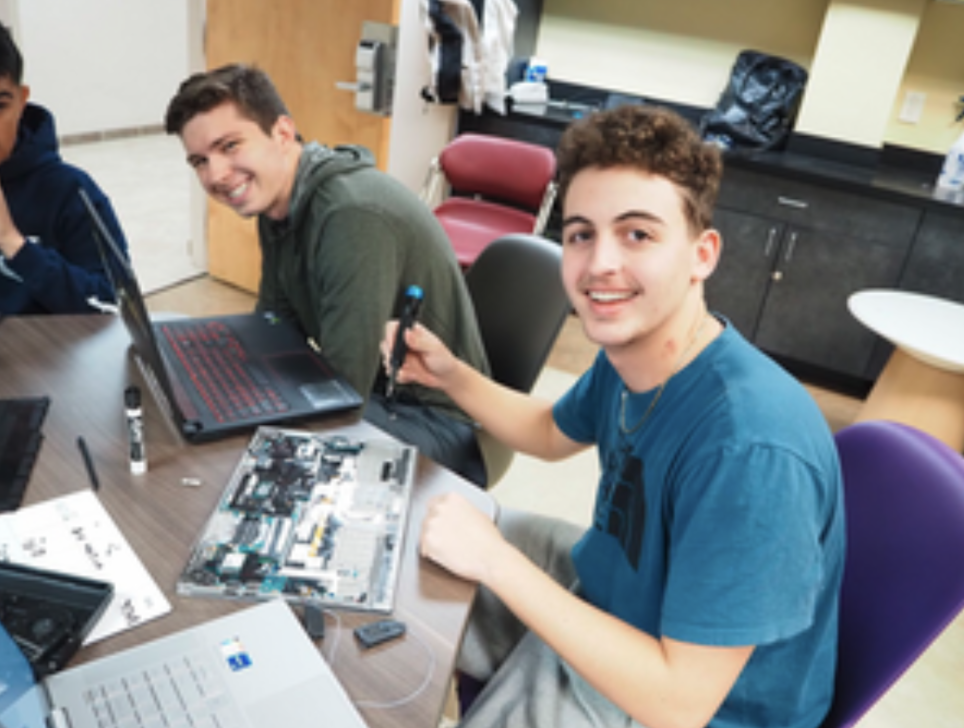July 2025
iFixit collaborates with educators and students to create and share repair knowledge
At iFixit, we spend a lot of time thinking about what happens when things break. Because when they do, most people are left with few options — and even fewer resources. We live in a world where repair is often discouraged or outright blocked. When devices are locked up with proprietary screws or glued shut to dissuade disassembly, and when parts are hard or impossible to find, the default response to a cracked screen or a dying battery is to abandon the entire device and replace it with something new. That mindset has real consequences.
E-waste is one of the fastest-growing waste streams on the planet. We're not just tossing out broken phones and laptops—we're throwing away the rare earth metals, the energy, and the labor that went into making them. Earth’s resources aren’t infinite, and rampant consumerism comes at a cost that neither we nor our planet can afford. That’s why iFixit set out to do something about it.
Fostering a Culture of Repair
Student team photo-documenting device disassembly for iFixit Technical Writing Project.
iFixit is widely-known for establishing and hosting the world's largest community-driven collection of DIY repair guides. We’re also a community hub for the global repair movement that works broadly to advance repair and to reset the narrative, normalizing repair. That’s why we also write and share stories about e-waste, corporate obstruction, and grassroots efforts to fix the system. Our blog and newsletter dig into the issues that matter, from new repair laws to teardowns of the latest tech. And we are relentless Right to Repair advocates.
Advancing repair creates communities rooted in collaboration, care, and collective problem-solving. Repair becomes more than a skill – it becomes a shared ethic of resilience and responsibility.
Repair and Education
We understand that educating our young people is essential for repair to become (again) a normal and actionable response to broken objects. Repair education doesn’t just teach students how to replace a battery or cracked screen—it teaches them to think critically about the systems around them. A broken laptop becomes a design flaw to analyze. A sealed device sparks conversations about ownership and access.
Students begin to ask deeper questions: How are things made? Can they be fixed? Who fixes them? Why is repair so often discouraged? Teaching students repair is a hands-on way to connect them to broader ideas about sustainability, critical thinking, and self-sufficiency.
Engaging K-12 Students
While our university-level iFixit Technical Writing Project is our current educational focus, we know that youth learning about repair is critical, so we leverage our resources to support local, national and international work in K-12.
Device Take-Apart Activity with iFixit staff, STEAM for Girls Camp.
On the ground that means we take every opportunity we can to work with our local K-12 community here in San Luis Obispo, California. As an example, for several years, we’ve mentored at STEAM for Girls Camp, which offers programs designed to encourage girls’ interest and confidence in going into STEAM fields. Last year, we built circuit continuity testers together from scratch!
iFixit EDU class visit to Shell Beach Elementary School.
At Shell Beach Elementary, we’ve guided groups of fifth-graders through the steps of repair: troubleshooting, diagnosis, and component replacement. They seemed to love getting to know the anatomy of electronics almost as much as we do! Demonstrating that electronics are fixable—not just mysterious black boxes—is the first step in changing the “broken = trash” mentality so prevalent in today’s society.
iFixit’s Director of Sustainability Elizabeth Chamberlain working with an OUSD Tech Repair student at the 2024 Repair Independence Day celebration in Sunnyvale, California (Photo credit: Ben Lohrentz)
At the national level, through our Pro Program we’ve supported awesome programs like Oakland Unified School District’s Tech Repair Hub in California and South Portland High School’s Riot Refurb in Maine. These students aren’t just fixing laptops — they’re learning valuable job skills, reducing e-waste, providing low-cost tech to their communities, and becoming local repair leaders. And education startups like Team.Repair in the UK are able to reach more students with their innovative programs with the help of our tools, materials, and inspiration.
In the virtual world we created the K-12 Educator Tool Chest, a suite of lessons and activities centered on sustainability and repair which we’ll continue to expand as resources are developed. Complementing the Tool Chest, we compiled K-12 Educator Resources, a catalogue of links to resources created by iFixit and others about the many dimensions of repair in society, the economy, the environment, and more. Our blog posts’ and newsletters’ deep dives into critical dimensions of repair form a rich library for research and teaching. All of this information is available to repair-minded educators looking for resources to include in their lessons, assignments, and classroom activities.
At the international level, through our robust communications infrastructure – newsletters, blog posts, website and social media – we significantly expand the reach of others’ K-12 educational work, such as The Culture of Repair Project, Fixit Clinic and The Restart Project.
iFixit is committed to advancing repair through educating our young people. We’re enthusiastic about further developing our support of K-12 educators.
Engaging University Students – iFixit Was Founded by Cal Poly Undergrads
Back in 2003, when one of their computers broke, college roommates Kyle Wiens and Luke Soules decided to take matters into their own hands by fixing it themselves. Frustrated with the struggle to source replacement parts, they started harvesting parts from broken devices and selling them online, turning a dorm room project into a small business.
Recognizing that access to parts and tools are just one part of the repair equation, they began creating photo-rich repair guides and posting them online for free. This collection of guides grew into the world’s largest community-driven repair wiki, editable by anyone and now accessed by tens of millions of fixers around the globe each year.
With thousands of new electronic devices hitting the market every year, they realized quickly that the need for repair information greatly outpaced their own staff’s ability to create it. So they asked: How can we collaborate with faculty to engage classrooms full of university students to help tackle the problem? Enter iFixit EDU and the birth of our formal education program.
The iFixit Technical Writing Project
Students disassembling laptop for iFixit Technical Writing Project.
In 2009, we piloted a hands-on repair documentation project at California Polytechnic State University in San Luis Obispo—the same campus where iFixit was founded. The project linked classroom learning with real-world impact, engaging engineering majors and technical writing students to create easy-to-follow repair guides for a wide range of devices, from electronics like laptops and smartphones to household appliances like vacuums and coffee makers.
Building on the success of that initial pilot, and incorporating the valuable feedback we received from both instructors and students, our educational offerings have since evolved into a suite of projects that collectively are known as the iFixit Technical Writing Project.
Students shooting photos for their repair guides for iFixit Technical Writing Project.
How It Works
Instructors choose from a menu of repair-related projects that align with their course goals. Whether it’s creating troubleshooting pages and comprehensive sets of repair guides for a device or refining existing guides that need a little polish, we’ve developed projects to suit a range of classroom needs and course modalities.
While students are working on their projects, iFixit EDU’s team of technical writers provides guidance by answering questions, reviewing student work, and providing detailed feedback to ensure that the repair information students create is clear, accurate, and understandable by the general public.
Once finalized, these student-created guides are published on the iFixit repair wiki, where they become part of an ever-expanding global resource of repair knowledge. Every year, millions of people around the world rely on this wiki to fix their devices—making student contributions both educational and impactful.
All project instructions and resources are hosted on edu.ifixit.com, making them easy to access on any device, whether students are working from a laptop, phone, or tablet.
Our Impact
Since launching the iFixit Technical Writing Project, we’ve worked with more than 32,000 students from 102 universities to create more than 56,000 repair guides. Our featured student guides collection illustrates the exemplary work that students have produced. Their guides have collectively empowered millions of people to fix their stuff. We estimate that over 1,000,000 devices have been saved from landfills due to the noble efforts of students and their instructors.
Our program just wrapped its 15th academic year, and its impact is now generational: we’re proud to partner with a handful of instructors who participated in the project when they were students and who now incorporate it into the courses they teach.
If you’re an educator interested in learning more about the program, check out our Prospective Universities page or reach out to us at education@ifixit.com.
iFixit and Education
Knowing that lasting change starts with education, we’re inspired by and committed to supporting the people bringing repair into classrooms, labs, and makerspaces across the country and around the world.
We’re grateful to be part of that community. With a mission to empower everyone to fix every thing, our co-founder Kyle Wiens often points out that education is at the heart of everything we do. Working together, he says, “we can create a culture that repairs and maintains the things we own, rather than discarding them and buying new.”
iFixit Resources for Educators and Students
iFixit Technical Writing Project + Supplemental Educational Resources
Our repair curriculum has been integrated into the coursework at over 100 post-secondary institutions, from community colleges through graduate programs. We’ve developed a host of supplemental resources — from Screwdriver Best Practices to Recognizing and Disconnecting Cable Connectors — that can be used or adapted for younger students. Access the collection of Student Resources here.K-12 Educator Tool Chest
We’ve built a free, dedicated hub for K-12 educators that includes lessons and activities centered on sustainability and repair. It’s designed to help teachers easily bring repair into the classroom. We hope to expand on this collection over time.Pro Program
We offer discounted tools and parts to educators through our iFixit Pro program, because we know budgets are tight and screwdrivers don’t grow on trees. We also support donations and bulk orders in support of community initiatives.Repair Guides for Every Thing
Like Wikipedia, this community-driven effort has grown into the largest collection of free repair information on the planet. But there’s still so much more to include, and your students can help. Anyone can contribute — learn how here. And check out this Kid Fixers group to inspire you and your students.Repair Skills Wiki
New to soldering? How about sewing? Explore the Skills Wiki to learn the basics and increase your students’ confidence with essential tools and techniques.Repair + Research Materials
From DIY repair guides to deep dives into e-waste and circular design, our materials cover both the how and the why of repair. We want people not only to fix things—but to think about the systems that break them in the first place.Right to Repair
What is Right to Repair and why does it matter? Help your students understand the reasons behind the movement by exploring this explainer. We’ve also distilled the issue into a brief educational video. Keep up with the latest news stories under these related categories on our blog: Right to Repair, Legislation, Consumer Rights.
All photo credits iFixit, unless otherwise noted.








